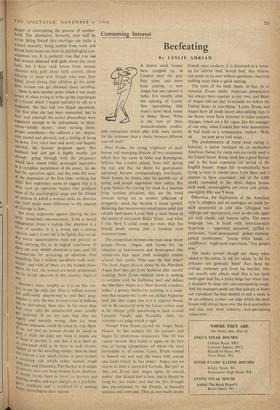Consuming Interest
Beefeating
By LESLIE ADRIAN
Peter Evans, the young originator of steak houses and managing director of two restaurants which bear his name in Soho and Kensington, believes that London palates 'Went dull'. during the war, and that the desire for gastronomic adventure became correspondingly .low-.keyed:. Steak houses, he thinks, take the gamble out of eating and people appreciate their safety. But Lyons believe the craving for steak is a reaction from wartime privation; they see the trend towards dining out as another reflection of prosperity—steak has become a• status symbol. Believing that bUsinessmen would prove solid and reliable beef-eaters Lyons bOili a steak house in the centre of mercantile Baker Street: and when I was there I could count no more than five female heads among over a hundred Male executive types.
The competition between the main steak house groups. Evans. . Angus. and Lyons—for the attention of businessmen and theatregoers (the restaurants stay open until midnight) centres around their steaks. Who uses the best meat? lite three Angus Houses swear by the Aberdeen Angus beef they get from Scotland after careful scouting. Peter Evans believes there is nothing to compare with his Galloway beef and defines the Aberdeen Angus as a 'short-horned crossbred heifer,' a genetic distinction pointing to a weak- ness that escapes me. Lyons use chilled Argentine beef, but they argue that it is a superior brand, not to be compared with the frozen sirloin used at the cheaper grills specialising in steak around Leicester Square and Piccadilly Only the customer can judge w hich is right.
Though Peter Evans started the Angus Steak Houses. he has recently left his partners and begun his eponymous restaurants. The rift was caused because they failed to agree on the best way of facing competitors—of whom the most formidable is, of course, Lyons. Evans wanted to branch out and vary the menu with scampi and lamb (which he has done): Angus saw no reason to alter a successful formula. But split as they are, Evans and Angus agree on several points: that Scotch beef is best; that it should be hung for two weeks: and that the filet, brought into pre-eminence by the French, is basically tasteless and overrated. They do not much admire French meat cookery; it is dismissed as a cover- up for inferior beef. Scotch beef, they believe. can stand on its own without garniture, requiring nothing more than a quick searing.
The roots of the steak house, in fact, lie in America.. Evans thinks American presentation has always been superior to our own, and Beale of Angus told me that 'eventually we follow the United States in everything.' Lyons, Evans and Angus have all made recent idea-seeking trips to the States; some have returned to make concrete changes, others are a bit vague, like the manager of one who, when I asked him what innovations he had made as a consequence, replied: 'Well, uh . . . wo.now serve iced water. . .
The predominance of rump steak eating :s. however, a native variation on an unabashed American theme, for rump cuts are rarely used in the United States. Rump steak has a good flavour and is the least expensive cut served at the English houses. Angus has systematically been trying to woo its clients 'away from fillets and it appears to have succeeded: out of the 4,000 steaks consumed in the three Angus houses each week, seven-eighths are rump and sirloin, one-eighth fillet and T-bone.
Otherwise,, the duplication of the American style is complete and no apologies are made for such accessories as cote slaw (chopped raw cabbage and mayonnaise), corn on the cob, apple pie with cheeSe, . and banana splits. The menu language, too, is laced with American-style hyperbole — 'supremely succulent; 'grilled to perfection,' food unsurpassed,' grilled morning- picked mushrooms,' young white heads of cauliflower; 'eagle-eyed supervision,' tiny garden peas.'
The steaks served--though not cheap when added to the extras, 2s. 6d. for salads, Is. 6d. for potatoes—are generally better than those the average consumer gets from his butcher, who can usually only obtain steak that is too fresh (well-aged beef has a pinky-beige hue when raw; it shouldn't be deep red) and consequently tough. And the managers point out that nobody at home can reproduce the heat needed to seal a steak in on an ordinary cooker—an edge which the steak houses will always have over the do-it-yourselfers and also over most ordinary, non-specialising restaurants.














































 Previous page
Previous page